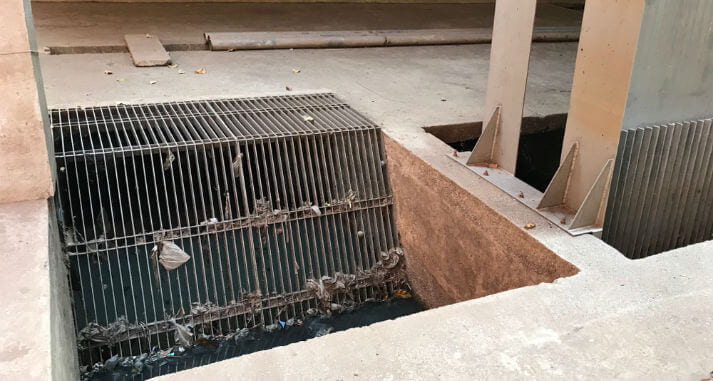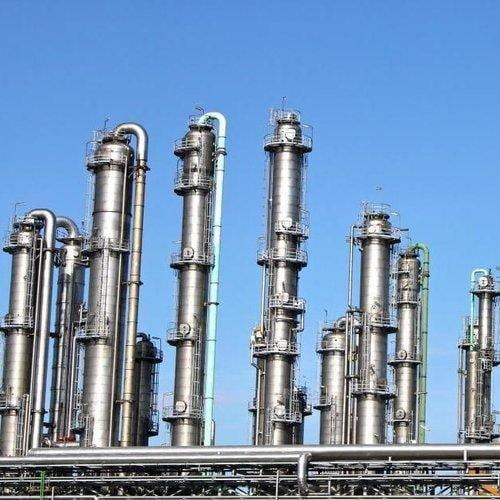Since my last post dealt with the importance of water treatment in Singapore, I think it’ll be quite fitting to make this one about the process of water treatment. PUB actually has rather well designed and concise infographics that introduces their water treatment system (check this and this out for more information). Therefore I’ll add on some details they may have missed out on, and also tap on my personal knowledge of the treatment techniques used by Toxic Industrial Waste Collectors (TIWCs) in Singapore from my internship.
Let’s try a little exercise! Head to Google Maps and look up satellite images of PUB’s water reclamation plant in Singapore. What caught your eye?
Was it these structures? I sure hope so! These are the core part of most water treatment plants, the bioreactors and clarifiers for settling bacteria aggregates after biochemical treatment.
These are like giant beer barrels; except instead of yeast, the bacteria cultures used are designed to digest and break down a wide variety of polysaccharides, lipids, and other pollutants.
They are the workhorse of any water treatment facility and help cut BOD and COD of wastewater down to safe levels for human use. The other processes of a water treatment plant revolve around the welfare and performance of these little guys.
The bacteria require high surface area access to pollutants, but high TSS and settleable solids just get in their way. Therefore, plants incorporate filter screens to remove large settleable solids and chemical coagulation and clarification of TSS.

Bar screen for filtering large settleable solids. Source: https://aosts.com/types-wastewater-screening/
Saline wastewater reducing the productivity of bioreactor? (Linaric et al., 2013) Then pass the wastewater through a distillation set up to reduce TDS through evaporation!

A multiple-effect(stage) Distillation set up for lowering TDS Source: https://gemina.es/files/catalogue/pdf/18_Evaporadores_ING.pdf

Multiple-effect distillation columns Source: https://www.indiamart.com/proddetail/distillation-column-21227565788.html
Heavy metals slowing down the growth of bacteria? (Cabrero et al., 1998) One of our TIWCs implemented an Electric Coagulator that precipitates charged aqueous metal ions as solid metal particles out for filtration without the use of chemicals!
Refractory non-biodegradable VOC and SVOC like tetrahydrofuran slowing down or even sterilising bioreactors? (Yao et al., 2012) Actually, that’s one of the headaches plaguing water treatment in Singapore at the moment! Fortunately, novel technologies are being experimented and pilot tested by PUB and a few TIWCs. I’ll be covering this in a later post.
After the bioreactors have done their job, its time to add final touches to the water. This depends on what the water is being used for. Domestic and industrial potable use calls for pH balancing and sterilisation. Specialised industries that need ultra-pure water go to NEWater, where our crème de la crème of water treatment technologies resides.
Every step along the way is filled with its own intricacies and face their own set of problems that probably deserve articles of their own. Plenty of research is being done along every step, and novel technologies are being thrown around left and right. However, a healthy dose of scepticism due to economic feasibility, performance, and stringent policies blocks the path of innovation. Let’s hope it does not come down to environmental degradation and human death to get things moving.
Gallery


Satellite Images of Kranji(Top) and Jurong(Bottom) Water Reclamation Plant. Source: Google maps

Close-up of a clarifier for settling bacteria aggregates after biological treatment. Source: https://www.pub.gov.sg/usedwater/treatment/usedwatertreatmentprocess

Aerated Activated Sludge Tank. Source: https://www.watertechonline.com/sludge-treatment-efficiency/
References
Cabrero, A., Fernandez, S., Mirada, F., & Garcia, J. (1998). Effects of copper and zinc on the activated sludge bacteria growth kinetics. Water Research. https://doi.org/10.1016/S0043-1354(97)00366-7
Linaric, M., Markic, M., & Sipos, L. (2013). High salinity wastewater treatment. Water Science and Technology. https://doi.org/10.2166/wst.2013.376
Yao, Y., Lu, Z., Min, H., Gao, H., & Zhu, F. (2012). The effect of tetrahydrofuran on the enzymatic activity and microbial community in activated sludge from a sequencing batch reactor. Ecotoxicology, 21(1), 56–65. https://doi.org/10.1007/s10646-011-0765-3
FYI,
I see continual effort to make writing more relatable, and this is all interesting.
Suggestion: some abbreviations (e.g., BOD) will be familiar to your peers, but others (e.g., COD, SVOC) won’t, so you might want to spell them out.
And a tip to raise the “environmental issues” aspect… maybe you could have started by briefly presenting the problem in terms of what these plants receive, i.e., the amt of rainwater, wastewater & stormwater and what’s in it. You know, because I’m not sure everyone connects what they see flowing in our drainage ditches with what comes out of our tap. So while I still feel a blog theme about water treatment is appropriate for an ENV1101, I’m looking for consistent links between the content and the environmental aspect.
PS, you might want to Google water treatment plant failures, e.g., Walkerton, Ontario, or the problems plaguing indigenous peoples around the world, and showcase what happens when ppl don’t have adequate services.
Hi Dr Coleman, I’ve hyperlinked the terms toward the Glossary page so that readers can refer to the terms and their full forms.
This post was meant as an introduction to the process of water treatment, and I was apprehensive about it due to the lack of an overarching issue.
I was contemplating whether to have this post in another Process page but I figured too many extra pages would be bad, so I framed the process of water treatment in Singapore in my personal take for this post.
I plan on using future posts to cover environmental issues and linking them to water treatment, so no more of these explanatory posts. My next post will be about Japan’s recent decision to dump radioactive water into the sea. There’s not much I can link to Singapore, but it came up so recently that I thought to post my thoughts about it would be quite fitting with regards to the “beyond” aspect!